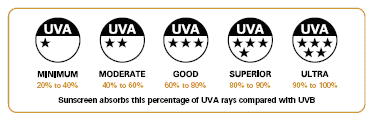Star rating system[edit]In the UK and Ireland, the Boots star rating system is a proprietary in vitro method used to describe the ratio of UVA to UVB protection offered by sunscreen creams and sprays. Based on original work by Prof. Brian Diffey at Newcastle University, the Boots Company in Nottingham, UK, developed a standard method that has been adopted by most companies marketing these products in the UK. The logo and methodology of the test are licenced for a token fee to any manufacturer or brand of sunscreens that are sold in the Boots retail chain, provided the products to which the logo is applied perform to the standard claimed. Own Label products exclusively sold in other retailers are now excluded from the terms of the licence. It should not be confused with SPF, which is measured with reference to burning and UVB. One-star products provide the least ratio of UVA protection; five-star products are best. The method has recently been revised in the light of the Colipa UVA PF test, and with the new EU recommendations regarding UVA PF. The method still uses a spectrophotometer to measure absorption of UVA vs UVB; the difference stems from a requirement to pre-irradiate samples (where this was not previously required) to give a better indication of UVA protection, and of photostability when the product is used. With the current methodology, the lowest rating is three stars, the highest being five stars. In August 2007, the FDA put out for consultation the proposal that a version of this protocol be used to inform users of American product of the protection that it gives against UVA,[32] but after concern this would be too confusing this was not adopted.[27]

